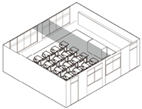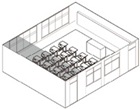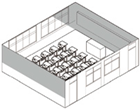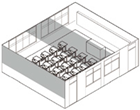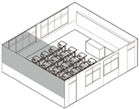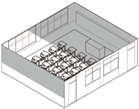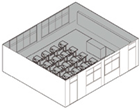Abstract
Acoustic standards for classrooms around the world are still being studied, but the placement of sound-absorbing materials to meet these standards is still unclear. The present study examined an appropriate location for applying sound-absorbing materials inside an elementary classroom to ensure speech intelligibility while meeting the RT criterion using three scientific experimental methods, namely, computer modeling, a 1/10-scale model, and field acoustic measurement. A sound-absorbing material was applied to the rear wall or ceiling, and the ceiling was further divided into front, center, and rear sections. The acoustic performance was predicted using a 3D computer model of a standardized classroom based on the location of the sound-absorbing material. Subsequently, a 1/10-scale model following the law of similarity was used to compare the acoustic performances based on the location of the sound-absorbing material. Finally, field measurements were performed in an actual classroom to verify the acoustic performance based on the location of the sound-absorbing material. The findings revealed that the sound-absorbing material was most effective when applied to the rear wall, followed by application at the center, front, and rear of the ceiling.
1. Introduction
Elementary school children are less able to perceive speech than adults, owing to their underdeveloped hearing. Nilsson et al. [1] used the hearing-in-noise test (HINT) to demonstrate that hearing and speech-perception abilities change with age. Adolescents (≥14 years in age) have the same hearing ability as adults, but children under 10 years old have considerably lower speech perception in a noisy environment. Because elementary school is the first stage of education, it considerably affects future learning. The hearing abilities of lower elementary students must be considered when designing classrooms to facilitate their education. The following acoustic standards for lower elementary students have been proposed in Korea to ensure speech intelligibility [2,3]: a reverberation time (RT) of <0.6 s (unoccupied) and background noise level of <35 A-weighted decibels (dB(A)) for a classroom volume of <185 m3. Ensuring that the acoustic environment of lower elementary classrooms meets these standards will help to improve the learning efficiency of students. Decades of research on classroom acoustics and the effects of poor classroom acoustics on listening and learning have resulted in certain tenets concerning classroom acoustics [4]. RT and background noise are very important factors in indoor spaces, including classrooms. In particular, excessive background noise and reverberation have been found to exacerbate listening and learning problems [5,6,7]. For this reason, RT and background noise are measured a scientific method. Therefore, many researchers worldwide have suggested RT and background noise criteria specific to each country’s language.
However, merely applying RT and background noise criteria to classrooms is insufficient. In fact, various parameters (e.g., clarity within 50 ms (C50) and the speech transmission index (STI)) can be used to evaluate acoustic environments, some of which have already been reflected in national classroom acoustic standards. However, unlike the parameters that can be used to assess the clarity and quality of speech, discussions on the Deutlichkeit (D50) index, which can be used to evaluate definition, have been held but are not reflected in such standards. Classrooms, lecture halls, auditoriums, congress halls, and theaters must provide good speech intelligibility, which necessitates sufficient speaker loudness, unimpeded direct sound propagation, a high reflection energy within the first 50 ms (path difference of 17 m) after the arrival of direct sound, and a short RT [8]. Haas [9] found that early reflections with a delay of up to ~50 ms can improve speech intelligibility by reinforcing the direct sound energy. Accordingly, Thuele [10] proposed D50, which is defined as the ratio of direct sound (first 50 ms) to total energy:
In Equation (1), p(t) means the instantaneous sound pressure of the impulse response measured at the measurement point. The equation for C50, which is frequently used in classrooms to assess speech clarity, is shown in Equation (2). C50 can also be calculated using D50, as shown in ISO3382-1. If D50 is greater than 50%, a syllable intelligibility of >90% can be expected. Thus, in a classroom where speech transmission is important, D50, RT and background noise are critical acoustic parameters. Ansay and Zannin [11] conducted an experimental study on the relation between RT and D50 and concluded that classrooms should have an evenly distributed D50 at every seat to ensure that all students can hear properly. Even if the acoustic standards for RT and background noise are met, applying sound-absorbing materials to the wrong locations in a classroom can disrupt the even distribution of D50. Therefore, the present study investigates the optimal placement of sound-absorbing materials in classrooms based on the relation between RT and D50, which can be used to create high-quality acoustic environments. The STI defined in IEC 60268-16 [12] can be calculated using Equation (3). STI is an acoustic factor that is so critical that some countries have set it as a standard. αk denotes gender-specific weight factor for octave band k, Mk denotes the modulation transfer index for octave band k, and βk denotes the gender-specific redundancy factor between octave band k and octave band k + 1. However, in the present study, D50 was used as a measurement factor to understand the level at which the teacher’s direct voice is evenly transmitted to the students within 50 ms for clear speech transmission in a small space such as a classroom.
Many researchers have studied the effect of the placement and quantity of sound-absorbing materials on classroom acoustics. For example, Sala and Viljanen [13] determined the most effective acoustic treatment for classrooms by varying the amount of sound-absorbing material in different arrangements. Their results suggested that to realize acceptable acoustic conditions for speech intelligibility, the sound-absorbing material should be distributed across at least two surfaces (e.g., ceiling, and back wall) and cover approximately 30% of the combined surface area of the walls and ceiling. They found that increasing the quantity of the sound-absorbing material resulted in higher building material costs, a marginal improvement in speech intelligibility, and excessive sound-level attenuation. Bistafa and Bradley [14] comprehensively investigated various acoustic treatments with varying amounts of a sound-absorbing material. They examined the efficacy of these materials by testing the same quantity in various configurations. They compared the predictability of the RT of a simulated rectangular classroom for different sound-absorbing material configurations using seven analytical expressions and two-room acoustic software (ODEON 2.6 and RAYNOISE 3.0). They found that none of the analytical expressions or acoustic software consistently predicted the RT within an accuracy of 10%. The amount and distribution of sound-absorbing material in the room affected the accuracy of the analytical expressions. Among the tested expressions, the Arau–Puchades formula [15] was the most accurate in predicting RTs, with the smallest average relative error. Notably, Bistafa and Bradley’s measurements for different sound-absorbing material configurations found variations in the average RT of up to 0.3 s. This observation was attributed to the increased efficiency of the sound-absorbing material when uniformly distributed throughout the room. Cucharero et al. [16] tested a sound-absorbing material placed on the walls and at the ceiling boundaries in a reverberation room and mockup classroom. Their results showed that sound-absorbing material was less effective for diffuse sound fields when mounted on the corners or at the edges between the walls and ceiling. If the room mode dominates the sound field, the most efficient location for the sound-absorbing material was one of the surfaces that caused the modes. Furthermore, an excessively short RT, caused by the overuse of sound-absorbing material, is undesirable because teachers are forced to speak louder so that students in the back rows can hear [17]. Thus, determining the appropriate location and amount of sound-absorbing material in a classroom to meet the RT standard is considerably important.
Three scientific experimental methods—prediction, comparison, and verification—were applied in the present study to more accurately determine the optimal placement of sound-absorbing materials in Korean elementary school classrooms. First, a computer modeling was used to predict where sound-absorbing materials should be placed in a classroom and the effects of sound-absorbing treatments on speech metrics. A 1/10-scale model was used to compare appropriate locations for the application of sound-absorbing materials in a classroom. Finally, field measurements were performed to verify the appropriate locations for applying sound-absorbing materials in a classroom. The goal was to find the best location for applying sound-absorbing material in an elementary classroom to ensure an even D50 distribution while meeting the Korean standard for the RT in a classroom.
The present study presents a scientific and robust method for determining the optimal RT and highly uniform distribution of D50 in Korean elementary school classrooms. Furthermore, it has two objectives: (1) to determine the location and area of sound-absorbing materials with a uniform distribution of D50 and an RT of 0.6 s, and (2) to identify the difference in RT and D50 when the same material area is applied to different locations.
2. Classroom Acoustic Standards by Country
2.1. Acoustic Standards in Classroom
Many countries have established acoustic standards to ensure their classroom environments are appropriate for their respective languages and learning cultures. The United States has established subject-specific and classroom-size-specific RT and background noise standards [18]: an RT of <0.6 s for classrooms with a volume of ≤283 m3 and of <0.7 s for classrooms with a volume of 283–566 m3, as well as a background noise level of 35 dB(A) for all classroom sizes. These standards were established by considering a minimum signal-to-noise ratio (SNR) value of 15 dB(A) for speech recognition and a minimum sound pressure level from the teacher of 50 dB(A) [19]. The United Kingdom established standards for the RT and background noise based on the age and number of students and the size and type of classroom [20]: an RT of <0.6 s and a background noise of 35 dB(A) for elementary students. Germany established classroom-specific standards for the RT and background noise [21]: an RT of 0.32 log V−0.17 s (where V represents the volume) and background noise of 35 dB(A) for A3 classrooms. Italy based their acoustic standards on DIN 18041 and set the RT and background noise based on the classroom type [22]: an RT of 0.32 log V−0.17 s and a background noise of 38 dB(A) for A3 classrooms of <250 m3 and 41 dB(A) for A3 classrooms of >250 m3. New Zealand has different RT and background noise standards depending on whether the classroom is new or refurbished [23]: 0.4–0.5 s for elementary classrooms and 40 dB(A) for newly built classrooms and 45 dB(A) for refurbished classrooms. Table 1 shows the acoustic standards for each country.

Table 1.
Classroom acoustic standards by country.
2.2. Review of the Acoustic Criteria in Korean Classrooms
Korea has also researched classroom acoustic performance standards. Furthermore, acoustic performance standards have been suggested to create a listening environment that is suitable for learning in Korean middle- and high-school classrooms. The proposed standards are applicable to general classrooms of approximately ≤220 m3 when used by Korean middle- and high-school students with normal hearing [24]. In addition, acoustic standards for lower elementary school classrooms and learning spaces for the elderly have been proposed [25]. Table 2 shows the standards for background noise and RT in Korean middle- and high-school classrooms, lower elementary-school classrooms, and learning spaces for the elderly.

Table 2.
Acoustic standards for classrooms in Korea.
The standards for middle- and high-school classrooms are established by assuming a minimum sound pressure level of 50 dB(A) for teachers and a minimum SNR value of 15 dB(A) for adults to perceive speech. The standard RT is ≤0.8 s, the same as in the UK. Although the RT standard in the UK is not limited by classroom volume, the Korean standard is limited to general classrooms with a volume of approximately ≤220 m3. Moreover, the proposed RT standard for lower elementary classrooms is 0.6 s, which is the same as the standard for elementary classrooms with a volume of ≤283 m3 in the UK and US. Furthermore, the Korean standard for lower elementary classrooms is applied to general classrooms with a volume of ≤185 m3.
3. Methods and Materials
Many methods are used for predicting room acoustics. Computer modeling is widely used to predict acoustics in various spaces, such as classrooms, offices, and performance venues. Another traditional method for predicting acoustic performance is the 1/10-scale model. Field measurements are the most reliable and necessary method of investigating acoustic performance. All three of the aforementioned methods were used in the present study to determine if the D50 performance varies depending on where the sound-absorbing materials are placed in the classroom. The results of the three experimental methods used in the present study are not intended to be compared. Based on a comparison of the similarities between the three results from each method, the appropriateness of the placement of sound-absorbing materials in the classroom can be determined. Figure 1 depicts the process of the present study.
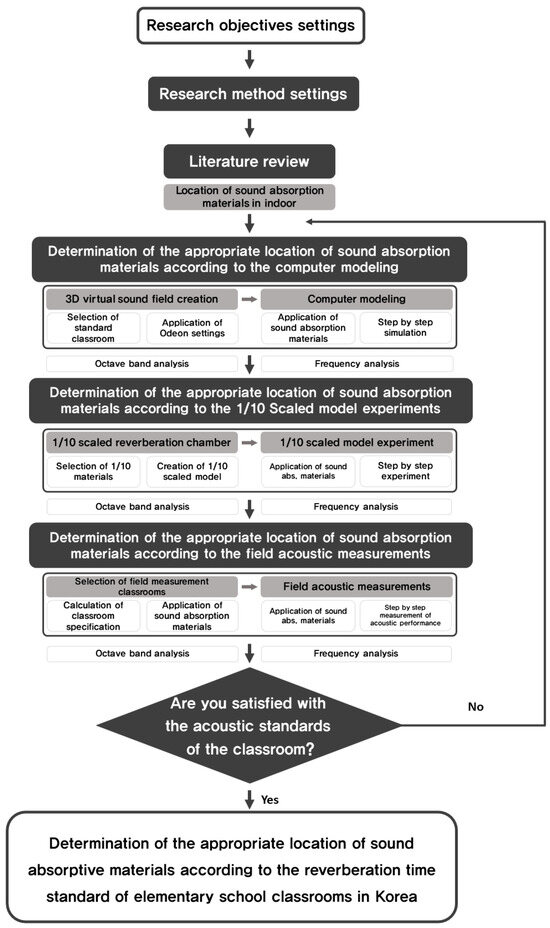
Figure 1.
Research flowchart.
3.1. Methods
Computer modeling was used in the present study to predict the appropriate location for the application of a sound-absorbing material in an elementary classroom. In AutoCAD 2023, a 3D model of a standardized classroom was created and imported into the architectural acoustics software ODEON 12.10. Acoustic parameters were then calculated by varying acoustic parameters such as finishing material and location. The 3D model needed to be closed on all sides to prevent rays from escaping, and the modeling precision affects modeling results. Increasing the number of surfaces and rays increases the modeling precision [28]. In a scaled model, depending on the temperature and relative humidity, the air can absorb most of the high-frequency sound [29]. To account for this, the temperature and humidity in the present study were measured in real-time using a thermo-hygrometer (TESTO 605-H1, Testo SE & Co. KGaA, Titisee-Neustadt, Germany). To maintain the relative humidity at 15% and the temperature at 15 °C–20 °C, a moisture-removal filter (SMC IDG30V, SMC Corporation, Chiyoda, Japan) and an air-compressor (SWC S30-40-3, SEOWON COMPRESSOR CO., LTD., Yongin, Republic of Korea) were used to inject dry air into the scaled model. Acoustic performance was measured in one-third octave bands ranging from 800 to 40k Hz using acoustics measurement equipment and Dirac 5.0 analysis software. The average relative humidity was maintained at 50%, while the temperature was maintained at 26 °C, during the field acoustic measurement. In the unoccupied and off states of the HVAC systems, the background noise in the lower-grade classroom of Elementary School K was 29.6 dB(A). Furthermore, the room acoustics measurement equipment and Dirac 5.0 analysis software were used to measure the acoustic performance in the frequency range of 125–4k Hz. Figure 2 depicts the acoustic performance measurement method used for each experiment.

Figure 2.
Measurement configuration: (a) computer modeling, (b) 1/10-scale model experiment, and (c) field acoustic measurement.
One sound source and four receiving points were assigned to the computer model. The sound source was placed at the front of the classroom, 1.5 m from the floor, to correspond to the height of the teacher’s mouth. According to ISO 3382-1 Annex A.3.1, the source should be omnidirectional, but tests related to human conditions may use a source with a similar directivity to that of a human [30,31]. A directional speaker was used as the sound source to mimic the characteristics of human speech transmission. At 1 m, the sound pressure level was set to 72 dB. The value of the noise criterion (NC) was set to 30. The receiving points were evenly spaced throughout the classroom to capture the acoustic performance at a height of 1.0 m, corresponding to the ear height of seated elementary students. One sound source and four receiving points were included in the 1/10-scale model. A directional speaker was installed at the front of the classroom, 0.15 m above the floor. The sound source was a 1.26 s swept sine signal played through a directional speaker at a sound pressure level of 72 dB(A). At the four receiving points at a height of 0.10 m, the swept sine signal was picked up by 1/8-in microphones (B&K Type 4165, Brüel & Kjær, Nærum, Denmark), and the arithmetic mean of 15 measurements was taken to improve the accuracy. The locations and types of sound sources and receiving points were the same in each experiment. The sound source for the measurements was a directional speaker (HERCULES 2000W, APL Technology Corp., Atlanta, GA, USA) playing an ISO 3382-2 [31] maximum length sequence (MLS) signal with the sound pressure level set to 72 dB(A). The signals were measured using a sound-level meter (NTi XL2, Nti Audio, Schaan, Liechtenstein, B&K Type 2270, Brüel & Kjær, Nærum, Denmark) at four receiving points, and three measurements of 10 s each were arithmetically averaged for accuracy. Figure 3 shows the locations of the sound sources and receiving points in the experiments.

Figure 3.
Locations of sound sources and receiving points in the experiments: (a) computer modeling, (b) 1/10-scale model experiment, and (c) field acoustic measurement.
3.2. Materials
3.2.1. Classification of Classrooms
The geometry of the classroom considerably affects the reflection and diffusion of sound waves. Accordingly, the present study establishes a standard classroom, and special types of classrooms, such as creative convergence classrooms, are excluded from the study’s scope. Although changes in teacher and student arrangements can improve speech intelligibility, changes in classroom layout (e.g., seating arrangement, furniture placement) do not directly affect the location of the sound-absorbing material.
Standardized classroom dimensions representing the architectural characteristics of elementary classrooms in Korea were calculated by averaging the architectural specifications of 10 classrooms in elementary schools in Cheongju [24]. The standardized classroom for computer modeling had dimensions of 7.3 (width) × 8.5 (length) × 2.6 m (height), corresponding to a width/length ratio of 1:1.16. This ratio created a 1/10-scale model measuring 0.73 (width) × 0.85 (length) × 0.26 m. Field measurements were performed in a classroom with dimensions of 7.3 (width) × 8.5 (length) × 2.6 m (height), resulting in a width/length ratio of 1:1.16. Figure 4 shows the dimensions of the classroom used in each experimental method.

Figure 4.
Dimensions of the standardized classroom used for (a) computer modeling, (b) the 1/10-scale model experiment, (c) and field acoustic measurements.
3.2.2. Sound-Absorbing Coefficient of Materials
Because sound-absorbing materials are used as finishing materials in the classroom, there are only acoustic influences, and no psychological influences of students’ or teachers’ communication, concentration, and overall learning experience. The walls in a real classroom have different finishes on all four sides. The front wall is finished with painted concrete and has a blackboard; further, the exterior side walls have windows, while the side walls facing the corridor have windows and doors. Moreover, the rear wall (RW) has lockers. Therefore, the sound-absorbing material on the back wall was placed 1 m from the floor in the computer model. Furthermore, finishing materials similar to those used in a real classroom were used. Scaled model experiments should adhere to the law of similarity [32]. In the present study, the sound-absorbing coefficients of several materials in the 1/10-scale model were directly measured in a scaled reverberation chamber [33] using the interrupted-noise method and a type A installation method in one-third octave bands from 800 to 40k Hz, as shown in Figure 5. The arithmetic mean of 15 measurements was taken to improve measurement accuracy. High-voltage spark sources limit control, and impulse response sources are not properly represented in the scale model. Therefore, a 12-sided omnidirectional speaker, reduced to 1/10 size, was used to conduct an ISO 354 [33] experiment in the scaled reverberation chamber. The scaled omnidirectional speaker that was used was built by us, and methods for producing scaled omnidirectional speakers are detailed in B. Chojnacki’s research results [34,35]. Furthermore, based on a study conducted by Baruch et al. [36], humidity was maintained at 10% because humidity absorption is high at high frequencies. The sound-absorbing coefficients of the finishing materials were determined for the field measurements based on the literature and empirical results provided by the manufacturers. The types of finishing materials and sound-absorbing coefficients used in the experiments are listed in Table 3. Using an appropriate sound-absorbing material is critical because its frequency-specific characteristics affect the indoor sound. Moreover, different types of sound-absorbing materials have different sound-absorbing coefficients; hence, a considerable difference in what kind of sound-absorbing materials are used in a classroom is likely to exist. The present study, however, did not compare different types of sound-absorbing materials.
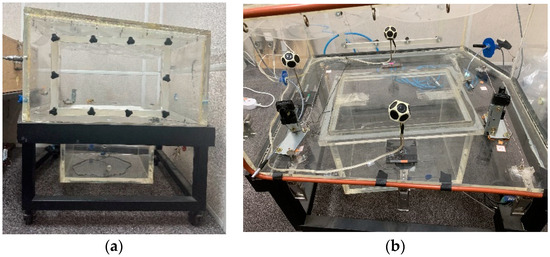
Figure 5.
Scaled reverberation chamber for measuring the sound-absorbing coefficient of materials: (a) appearance of a scaled reverberation chamber; (b) experimental conditions.

Table 3.
Finishing materials and noise reduction coefficients used in experiments.
3.3. Application of Sound-Absorbing Material in Classrooms
When sound-absorbing materials are used in a classroom, the sound-absorbing power of the space increases, resulting in a decrease in the RT and an increase in speech intelligibility. To maintain the durability of the sound-absorbing materials, the sound-absorbing materials that are placed in a classroom should be semi-permanent and their long-term usability should be considered; for example, they should not be installed on the floor. Many studies have investigated the effect of the placement of sound-absorbing materials on classroom sound. Some fixed factors in the classroom can affect how the sound-absorbing material is arranged. Accordingly, the location of the blackboard and storage unit was considered in the present study.
Bradley [37] reported that the surfaces surrounding a speaker should reflect sound, and that the amount and location of a sound-absorbing material are important for effective speech transmission. T. Lokki and A. Kuusinen [38] reported that a sound-absorbing material should be placed close to the sound source to maximize clarity. Jeong et al. [39] addressed the requirement for a suitable reflective surface on the ceiling to enhance direct sound. Sala and Viljanen [13] suggested applying sound-absorbing material to the back wall and ceiling to improve acoustic performance. Ryu et al. [40] demonstrated that an appropriate RT could be achieved by sound-absorbing material covering only a portion of the ceiling. To avoid damage, Russo and Ruggiero [41] suggested that sound-absorbing material be evenly distributed over the surfaces of a classroom at an appropriate height from the floor. Park [42] found that adding a sound-absorbing material to the side walls can result in inter-aural-level differences, reducing speech intelligibility. According to Berg et al. [43], adding a sound-absorbing material or carpeting to classroom floors generally improves the acoustic performance by reducing distracting noises (e.g., books/pencils dropping and chair scraping). However, Seep et al. [44] and Knecht et al. [26] found that carpeting marginally affects sound absorption in classrooms, and is not used owing to its potential risks, such as difficulties maintaining its sound-absorbing performance and risks to student health.
Based on the previous studies, the sound-absorbing material was not applied to the floor, front wall, or side walls of the classroom in the present study. Instead, only the RW and ceiling were considered as areas for the sound-absorbing material. Furthermore, the RW had a considerably smaller surface area than the ceiling. Therefore, the ceiling was divided into front, center, and back sections. Because of the reflection from the sidewalls, an even D50 distribution could not be obtained if the ceiling was divided lengthwise.
Based on the Sabine RT calculation formula shown in Equation (4), the required absorption area for the experimental space was determined to be 43.2 m2. Although this absorption area was not met, the primary goal was to demonstrate the difference in the acoustic performance when the sound-absorbing materials was applied to different placements with the same total area (see steps 1 and 2). The proposed placement method may be considerably simple for application in classrooms. Installing sound-absorbing materials in the front or center of a classroom ceiling can be challenging owing to practical issues, such as voice fatigue among teachers, and heating, ventilation, and air-conditioning (HVAC) systems. These cases, however, were critical for determining the difference in acoustic performance caused by the placement of sound-absorbing materials on the ceiling.
The sound-absorbing material was placed in a three-step procedure for all experiments, as shown in Table 4:

Table 4.
Experimental procedure for testing the acoustic performance of different sound-absorbing material configurations.
- The sound-absorbing material covering an area of 12.4 m2 was applied individually to the rear wall (RW), front ceiling (FC), center ceiling (CC), and rear ceiling (RC), and the acoustic performances were compared.
- Based on the results of step 1, the sound-absorbing material was applied to the RW, and sound-absorbing material covering 20.7 m2 was individually applied to the FC, CC, and RC for a total area of 33.1 m2. RW + FC, RW + CC, and RW + RC’s acoustic performances were compared.
- The sound-absorbing material was applied to the RW and CC based on the results of step 2. Then, for a total area of 53.8 m2, sound-absorbing material covering an area of 20.7 m2 was applied individually to the FC and RC. The acoustic performances of the RW + CC + FC, RW + CC + RC, and all parts of the ceiling (AC) were compared, with a total area of 62.1 m2.
4. Results
4.1. Computer Modeling
The RT and D50 for various configurations were calculated by averaging the values measured at the four receiving points (R1–R4). In step 1, the shortest RT of 1.18 s and highest D50 of 51% were obtained at the RW. In step 2, the shortest RT of 0.75 s and highest D50 of 62% were obtained at the RW + CC. In step 3, the shortest RT of 0.55 s and highest D50 of 0.71 were obtained at the RW + CC + FC. In addition, for each step, values within the JND of the highest D50 were checked. The standard deviation for each receiving point was calculated using these values [27,45]. The smallest standard deviations (1%) were obtained for the RW in step 1, RW + CC in step 2, and RW + CC + FC in step 3. The standard deviation was calculated only from the location corresponding to the JND. The results of the computer modeling are shown in Figure 6 and Figure 7.

Figure 6.
D50 and RT for each sound-absorbing material location in the computer modeling.
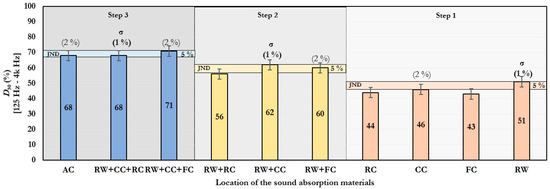
Figure 7.
D50 for each sound-absorbing material location and the standard deviation among the receiving points within the JND in the computer modeling.
4.2. 1/10-Scaled Model Experiment
The RT and D50 for various configurations were calculated by averaging the values measured at the four receiving points (R1–R4). In step 1, the shortest RT of 0.70 s and highest D50 of 46% were obtained at the RW. In step 2, the shortest RT of 0.60 s and highest D50 of 55% were obtained at the RW + CC. In step 3, the shortest RT of 0.52 s and highest D50 of 66% were obtained at the RW + CC + FC. Values within the highest JND of D50 were checked for each step, and these values were used to calculate the standard deviation for each sound-receiving point. The smallest standard deviations (1%) were obtained for the RW and RW + CC in step 1 and step 2, respectively. Step 3 was omitted because the standard deviation was calculated only where it corresponded to the JND. Figure 8 and Figure 9 show the results of the 1/10-scale model.

Figure 8.
D50 and RT for each sound-absorbing material location in the 1/10-scale model.
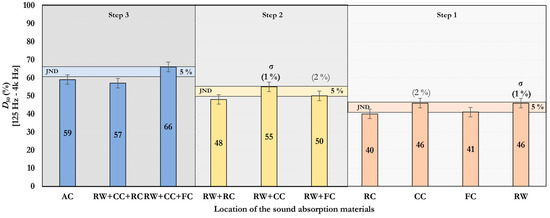
Figure 9.
D50 for each sound-absorbing material location and the standard deviation among receiving points within the JND in the 1/10-scale model experiment.
4.3. Field Acoustic Measurement
The values measured at the four receiving points (R1–R4) were averaged to analyze the RT and D50 for various configurations. Unfortunately, owing to ceiling damage in the actual classroom, step 3 could not be completed. In step 1, the shortest RT of 0.81 s and highest D50 of 68% were obtained at the CC. In step 2, the shortest RT of 0.73 s was obtained at the RW + FC, while the highest D50 of 72% was obtained at the RW + CC. All measurements were within the JND range. Values within the highest JND of D50 were checked for each step, and these values were used to calculate the standard deviation for each receiving point. The smallest standard deviations (2%) were obtained for the RW and RW + CC in step 1 and step 2, respectively. Figure 10 and Figure 11 depict the field measurement results.
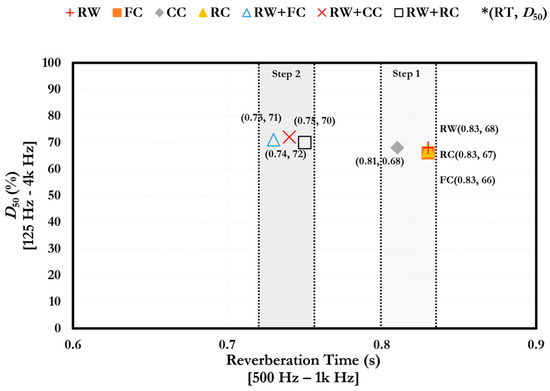
Figure 10.
D50 and RT for each sound-absorbing material location in the field acoustic measurement.
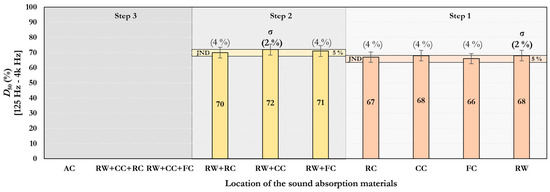
Figure 11.
D50 for each sound-absorbing material location and the standard deviation among sound receiving points within the JND in the field acoustic measurement.
4.4. Comparison among Three Experiments
For all experiments, the RW, RW + CC, and RW + CC + FC exhibited the lowest RT with a JND of 5%. Furthermore, for a JND of 5%, the RW, RW + CC, and RW + CC + FC exhibited the highest D50. Figure 12 presents a comparison of the RT and D50 values, which indicates that the shortest RT and highest D50 with the most even distribution was obtained with RW, RW + CC, and RW + CC + FC in step 1, step 2, and step 3, respectively. Figure 13 presents a comparison of the RT and D50 values obtained from three experimental methods. The three experimental methods showed similar trends but differed in the actual values, which were attributed to unavoidable issues with diffraction and low-frequency calculations in the computer modeling and high-frequency sound absorption in the 1/10-scale model. Although Bistafa and Bradley [14] found that the difference between computer modeling and measurements is greater when the space has less sound absorption, this difference decreases significantly as the level of sound absorption increases. The similarity of the trends among the experimental methods was statistically validated using the Spearman correlation coefficient, which yielded p-values of less than 0.05 for all experimental methods. Consequently, because the correlation was significant at the 95% confidence level, the results of each experimental method were concluded to exhibit the same trend. The correlations for each experimental method are shown in Table 5. These findings are consistent with those of Sala and Viljanen, as well as Ryu et al. [13,40], who concluded that applying a sound-absorbing material to the rear wall and a portion of the ceiling is effective. However, different results were obtained, due to differences in the research goals, from Lokki and Kusinen’s [38] research findings, which suggested that the absorption surface should be placed close to the sound source to maximize clarity. To achieve a rapid speech transmission index of 0.75, they suggested covering 30% of the total area with a sound-absorbing material on the ceiling and back wall. However, by covering 20% of the total area with the RW + CC configuration, the Korean standard of RT 0.6 s was met. The amount of sound-absorbing material required will vary depending on the acoustic standards of each country.
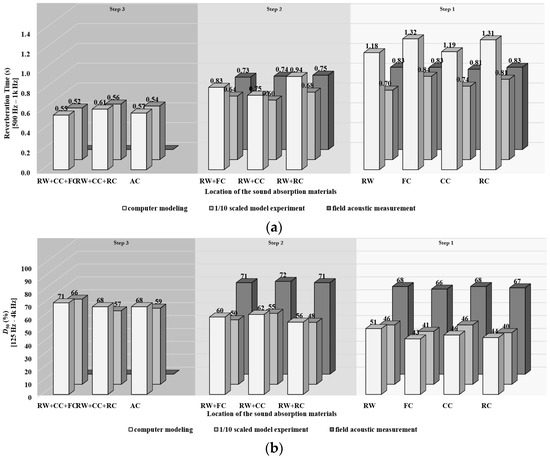
Figure 12.
Comparison of (a) RT and (b) D50 for different steps.
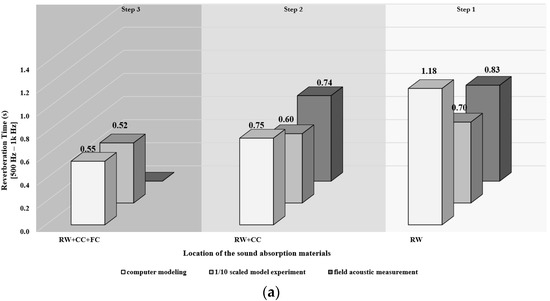

Figure 13.
Comparison of (a) RT and (b) D50 according to the optimal location in experimental method.

Table 5.
Spearman correlation coefficient analysis of RT and D50 for each experimental method.
4.4.1. Reverberation Time
Elementary classrooms in Korea should have an RT of <0.6 s [2]. Table 6 shows the configurations that produced RTs of ≤0.6 s. The 1/10-scale model yielded a shorter RT than the other experimental methods. RW + CC produced an RT of ≤0.6 s in step 2. Step 3 yielded a suitable RT for all three configurations, implying that a sufficient area of the elementary classroom must be covered with a sound-absorbing material to achieve the required acoustic performance. However, the RT may differ among classrooms. Therefore, the acoustic performance of existing classrooms should be investigated, and a sound-absorbing material should be gradually applied until the appropriate RT is achieved.

Table 6.
Comparison of RT among configurations and experimental methods.
4.4.2. D50
A D50 of >50% is required for speech intelligibility at all frequencies [46,47,48]. Table 7 shows that the measured values of D50 are greater than 50%. The D50 for the field measurement was higher than for the other experimental methods. The D50 standard was met at the RW in step 1. The D50 standard was also met in step 3 at the RW + CC. The field measurement results were not available in step 3, but the other two experimental methods indicated that the RW + CC + FC produced a D50 of ~70%, which would ensure a high level of speech intelligibility.

Table 7.
Comparison of D50 among configurations and experimental methods.
5. Discussion and Conclusions
The appropriate locations for sound-absorbing material inside an elementary classroom were determined in the present study to achieve an even D50 distribution while meeting the RT standard. Three different experimental methods were used to measure and compare the RT and D50 results for various configurations (Table 4). A summary of the findings is presented as follows:
- The RW produced the shortest RT and the highest and most even D50 in step 1, while the RW + CC produced the shortest RT and the highest and most even D50 in step 2. Further, the RW + CC + FC produced the shortest RT and highest D50 in step 3, despite using less sound-absorbing material than the AC. Thus, the RC + CC + FC is more economical and acoustically sound than the AC, despite the latter’s widespread use in Korean classrooms.
- The RW + CC + FC met the RT standard of <0.6 s suggested for elementary classrooms. Furthermore, the RW + CC met the requirement of D50 > 50%. The best configuration to ensure a high-quality acoustic environment for learning in a classroom appears to be RW + CC + FC.
- Even when side walls are excluded from the interaural level difference, the uniformity of D50 can vary depending on where the sound-absorbing materials are located within an area. The back walls of many Korean elementary school classrooms are frequently used as bulletin boards, but this should be improved to block late-reflected sound in small spaces like classrooms.
- In comparison to an RT of 0.6 s, speech intelligibility for D50 can be achieved with a smaller area of sound-absorbing materials. However, sufficient intelligibility values can be obtained if an RT of 0.6 s is achieved in Korean elementary school classrooms by strategically placing sound-absorbing materials.
- The current study examined the best location for sound-absorbing materials in Korean elementary school classrooms based on D50 and RT, the two important parameters in evaluating classroom acoustics. The findings reveal that the D50 can vary depending on the sound-absorbing materials’ locations. This can lead to improved teacher–student communication and an increase in satisfaction with the overall educational experience. However, several limitations should be mentioned. First, step 3 could not be performed in the field acoustic measurement due to damage to the classroom ceiling. Although this value can be predicted using scientific statistical methods, comparing it to actual experimental data would be inappropriate. Hence, it was regarded as a missing value in the present study. Furthermore, numerical simulations and scale modeling are suitable for acoustic design. Obtaining a full-scale object to derive some design principles is unnecessary. Second, the location of the sound-absorbing materials was only investigated with a small group of students, excluding teachers, and assuming that the classroom was mostly empty. When researching classroom acoustics, future researchers must consider the occupied/unoccupied states of classrooms and teacher fatigue. Finally, the present study compared the level of acoustic performance by dividing the ceiling into three equal parts based on the area of the rear wall. However, this method may have limitations in other classrooms due to factors such as HVAC systems and lighting. Overall, the findings of the present study and those of future studies based on these limitations can hopefully be used as guidelines for the development of national standards for classroom acoustic environments.
Author Contributions
Conceptualization, C.-H.H.; methodology, S.-M.L. and C.-H.H.; software, S.-M.L.; validation, S.-M.L. and C.-H.H.; formal analysis, S.-M.L. and C.-H.H.; investigation, S.-M.L. and C.-H.H.; resources, C.-H.H.; data curation, S.-M.L.; writing—original draft preparation, S.-M.L.; writing—review and editing, C.-H.H.; visualization, S.-M.L.; supervision, C.-H.H.; project administration, C.-H.H.; funding acquisition, C.-H.H. All authors have read and agreed to the published version of the manuscript.
Funding
This work was supported by the National Research Foundation of Korea (NRF) grant funded by the Korea government (MSIT) (NRF-2020R1A2C2009963) and conducted during the research year of Chungbuk National University in 2022.
Data Availability Statement
The raw data supporting the conclusions of this article will be made available by the authors on request.
Conflicts of Interest
The authors declare no conflicts of interest.
References
- Nilsson, M.; Soli, S.D.; Sullivan, J.A. Development of the hearing in noise test for the measurement of speech reception thresholds in quiet and in noise. J. Acoust. Soc. Am. 1994, 95, 1085–1099. [Google Scholar] [CrossRef] [PubMed]
- Jo, A.H.; Park, C.J.; Haan, C.H. Investigation of the appropriate reverberation time for lower-grade elementary school classrooms using speech intelligibility tests. Buildings 2022, 12, 808. [Google Scholar] [CrossRef]
- Park, C.J.; Lee, S.M.; Jo, A.H.; Haan, C.H. Influence of SNR on the speech perception of incomplete hearing people. Appl. Acoust. 2022, 201, 109091. [Google Scholar] [CrossRef]
- American Speech-Language-Hearing Association. Guidelines for Addressing Acoustics in Educational Settings. 2004. Available online: https://www.gofrontrow.com/resources/case-studies/guidelines-for-addressing-acoustics-in-educational-settings/ (accessed on 15 May 2022).
- Crandell, C.C.; Smaldino, J.J. Classroom acoustics for children with normal hearing and with hearing impairment. Lang. Speech Hear. Serv. Sch. 2000, 31, 362–370. [Google Scholar] [CrossRef] [PubMed]
- Nelson, P.B.; Soli, S. Acoustical barriers to learning: Children at risk in every classroom. Lang. Speech Hear. Serv. Sch. 2000, 31, 356–361. [Google Scholar] [CrossRef] [PubMed]
- Johnson, C.E. Children’s phoneme identification in reverberation and noise. J. Speech Lang. Hear. Res. 2000, 43, 144–157. [Google Scholar] [CrossRef]
- Kuttruff, H.; Mommertz, E. Room acoustics. In Handbook of Engineering Acoustics; Müller, G., Möser, M., Eds.; Springer: Berlin/Heidelberg, Germany, 2013. [Google Scholar]
- Haas, H. The influence of a single echo on the audibility of speech. J. Aud Eng. Soc. 1972, 20, 146–159. [Google Scholar]
- Thuele, R. Richtungsverteilung und zeitfolge der schallrückwürfe in Räumen. Acta Acust. United Acust. 1953, 3, 291–302. [Google Scholar]
- Ansay, S.; Zannin, P.H.T. Using the parameters of definition, D50, and reverberation time, RT, to investigate the acoustic quality of classrooms. Can. Acoust. 2016, 44, 6–11. [Google Scholar]
- IEC 60268-16:2020; Sound System Equipment—Part 16: Objective Rating of Speech Intelligibility by Speech Transmission Index. IEC: Geneva, Switzerland, 2020.
- Sala, E.; Viljanen, V. Improvement of acoustic conditions for speech communication in classrooms. Appl. Acoust. 1995, 45, 81–91. [Google Scholar] [CrossRef]
- Bistafa, S.R.; Bradley, J.S. Predicting reverberation times in a simulated classroom. J. Acoust. Soc. Am. 2000, 108, 1721–1731. [Google Scholar] [CrossRef] [PubMed]
- Arau-Puchades, H. An improved reverberation formula. Acta Acust. United Acust. 1988, 65, 163–180. [Google Scholar]
- Cucharero, J.; Hänninen, T.; Lokki, T. Influence of sound-absorbing material placement on room acoustical parameters. Acoustics 2019, 1, 644–660. [Google Scholar] [CrossRef]
- Nijs, L.; Rychtáriková, M. Calculating the optimum reverberation time and absorption coefficient for good speech intelligibility in classroom design using U50. Acta Acust. United Acust. 2011, 97, 93–102. [Google Scholar] [CrossRef]
- ANSI S12.60-2002; American National Standard Acoustical Performance Criteria, Design Requirements, and Guidelines for Schools. American National Standards Institute: New York, NY, USA, 2002.
- American Speech-Language-Hearing Association. Guidelines for Acoustics in Educational Environments; American Speech-Language-Hearing Association: Rockville, MD, USA, 1995; Volume 37, pp. 15–19. [Google Scholar]
- Building Bulletin 93; Acoustic Design of Schools. British Department for Education and Employment: London, UK, 2015.
- DIN 18041; Hörsamkeit in Räumen—Anforderungen, Empfehlungen und Hinweise für die Planung (Acoustic Quality in Rooms–Specifications and Instructions for the Room Acoustic Design). Beuth: Berlin, Germany, 2018.
- UNI 11532-2; Caratteristiche Acustiche Interne di Ambienti Confinati—Metodi di Progettazione e Tecniche di Valutazione—Parte 2. Settore Scolastico. UNI: Milano, Italy, 2020.
- New Zealand Ministry of Education. Designing Quality Learning Spaces—Acoustics v3.0; New Zealand Ministry of Education: Wellington, New Zealand, 2020. Available online: https://assets.education.govt.nz/public/Documents/Primary-Secondary/Property/Design/Flexible-learning-spaces/DQLS-Acoustics-v-3.0-16-December-2020-Final.pdf (accessed on 15 May 2022).
- Park, C.J.; Haan, C.H. Initial study on the reverberation time standard for the Korean middle and high school classrooms using speech intelligibility tests. Buildings 2021, 11, 354. [Google Scholar] [CrossRef]
- Lee, S.M.; Park, C.J.; Haan, C.H. Investigation of the appropriate reverberation time in learning spaces for elderly people using speech intelligibility tests. Buildings 2022, 12, 1943. [Google Scholar] [CrossRef]
- Knecht, H.A.; Nelson, P.B.; Whitelaw, G.M.; Feth, L.L. Background noise levels and reverberation times in unoccupied classrooms: Predictions and measurements. Am. J. Audiol. 2002, 11, 65–71. [Google Scholar] [CrossRef]
- Christensen, C.L.; Koutsouris, G.; Rindel, J.H. The ISO 3382 parameters: Can we simulate them? Can we measure them? In Proceedings of the International Symposium on Room Acoustics, Toronto, ON, Canada, 9–11 June 2013; Volume 910. [Google Scholar]
- Park, C.J.; Haan, C.H. Effects of the complexity of 3D modeling on the acoustic simulations and auralized sounds. J. Acoust. Soc. Korea 2011, 30, 22–32. [Google Scholar] [CrossRef][Green Version]
- Harris, C.M. Absorption of sound in air versus humidity and temperature. J. Acoust. Soc. Am. 1966, 40, 148–159. [Google Scholar] [CrossRef]
- ISO 3382-1:2009; Acoustics—Measurement of Room Acoustic Parameters-Part 1. Performance Spaces. International Standardization Organization: Geneva, Switzerland, 2009.
- ISO 3382-2:2008; Acoustics—Measurement of Room Acoustic Parameters-Part 2. Reverberation Time in Ordinary Rooms. International Standardization Organization: Geneva, Switzerland, 2008.
- Barron, M.; Chinoy, C.B. Auditorium acoustic modeling now. Appl. Acoust. 1983, 16, 279–290. [Google Scholar] [CrossRef]
- ISO 354:2003; Acoustics—Measurement of Sound Absorption in a Reverberation Room. International Standardization Organization: Geneva, Switzerland, 2003.
- Chojnacki, B. Miniature omnidirectional sound sources used in acoustic scale modeling-measurements and validation. Vib. Phys. Syst. 2022, 33. [Google Scholar] [CrossRef]
- Bartlomiej, C.; Sang-Ik, T.C.; Ravish, M. Full range omnidirectional sound source for near-field head-related transfer-functions measurement. J. Aud Eng. Soc. 2021, 69, 323–339. [Google Scholar] [CrossRef]
- Baruch, K.; Majchrzak, A.; Przysucha, B.; Szeląg, A.; Kamisiński, T. The effect of changes in atmospheric conditions on the measured sound absorption coefficients of materials for scale model tests. Appl. Acoust. 2018, 141, 250–260. [Google Scholar] [CrossRef]
- Bradley, J.S. Acoustical design of rooms for speech. In Institute for Research in Construction; National Research Council of Canada: Ottawa, ON, Canada, 2002. [Google Scholar]
- Lokki, T.; Kuusinen, A. Placement of absorption material: DIN 18041 is misleading. In International Conference on Auditorium Acoustics; Institute of Acoustics: Milton Keynes, UK, 2023. [Google Scholar]
- Jeong, D.U.; Oh, Y.K.; Chu, H.K. Spatial distribution of early reflection and speech intelligibility. J. Archit. Inst. Korea Suppl. 2001, 1, 537–540. (In Korean) [Google Scholar]
- Ryu, D.J.; Park, C.J.; Haan, C.H. Interior surface treatment guidelines for classrooms according to the acoustical performance criteria. J. Acoust. Soc. Korea 2016, 35, 92–101. [Google Scholar] [CrossRef][Green Version]
- Russo, D.; Ruggiero, A. Choice of the optimal acoustic design of a school classroom and experimental verification. Appl. Acoust. 2019, 146, 280–287. [Google Scholar] [CrossRef]
- Park, C.J.; Haan, C.H. Effect of the inter-aural level differences on the speech intelligibility depending on the room absorption in classrooms. J. Acoust. Soc. Korea 2013, 32, 335–345. [Google Scholar]
- Berg, F.S.; Blair, J.C.; Benson, P.V. Classroom acoustics: The problem, impact, and solution. Lang. Speech Hear. Serv. Sch. 1996, 27, 16–20. [Google Scholar] [CrossRef]
- Seep, B.; Glosemeyer, R.; Hulce, E.; Linn, M.; Aytar, P. Classroom Acoustics: A Resource for Creating Environments with Desirable Listening Conditions Report; Acoustical Publications Society of America: Melville, NY, USA, 2000. [Google Scholar]
- Pawirasasra, M.S.; Sampurna, R. The effect of boundary shape to acoustic parameter. J. Phys. Conf. Ser. 2016, 776, 012068. [Google Scholar] [CrossRef]
- Fasold, W.; Veres, E. Schallschutz und raumakustik in der praxis. In Planungsbeispiele Konstruktive Lösungen; Verlag für Bauwesen: Berlin, Germany, 1998. [Google Scholar]
- Queiroz de Sant’Ana, D.; Trombetta Zannin, P.H. Acoustic evaluation of a contemporary church based on in situ measurements of reverberation time, definition, and computer-predicted speech transmission index. Build. Environ. 2011, 46, 511–517. [Google Scholar] [CrossRef]
- Macho-Stadler, E.; Elejalde-Garcia, M.J. Measuring the acoustic response of classrooms with a smartphone. Phys. Teach. 2020, 58, 585–588. [Google Scholar] [CrossRef]
Disclaimer/Publisher’s Note: The statements, opinions and data contained in all publications are solely those of the individual author(s) and contributor(s) and not of MDPI and/or the editor(s). MDPI and/or the editor(s) disclaim responsibility for any injury to people or property resulting from any ideas, methods, instructions or products referred to in the content. |
© 2024 by the authors. Licensee MDPI, Basel, Switzerland. This article is an open access article distributed under the terms and conditions of the Creative Commons Attribution (CC BY) license (https://creativecommons.org/licenses/by/4.0/).


